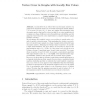17 search results - page 2 / 4 » Randomly coloring sparse random graphs with fewer colors tha... |
APPROX
2009
Springer
13 years 12 months ago
2009
Springer
We study the maximization version of the fundamental graph coloring problem. Here the goal is to color the vertices of a k-colorable graph with k colors so that a maximum fraction ...
FOCS
2003
IEEE
13 years 10 months ago
2003
IEEE
We study a simple Markov chain, known as the Glauber dynamics, for randomly sampling (proper) k-colorings of an input graph G on n vertices with maximum degree ∆ and girth g. We...
CP
2004
Springer
13 years 10 months ago
2004
Springer
Many backtracking algorithms exhibit heavy-tailed distributions, in which their running time is often much longer than their median. We analyze the behavior of two natural variant...
ICALP
2011
Springer
12 years 8 months ago
2011
Springer
In [13], Erd˝os et al. defined the local chromatic number of a graph as the minimum number of colors that must appear within distance 1 of a vertex. For any ∆ ≥ 2, there are ...
JGT
2010
13 years 3 months ago
2010
Sufficient degree conditions for the existence of properly edge-colored cycles and paths in edge-colored graphs, multigraphs and random graphs are inverstigated. In particular, we...

